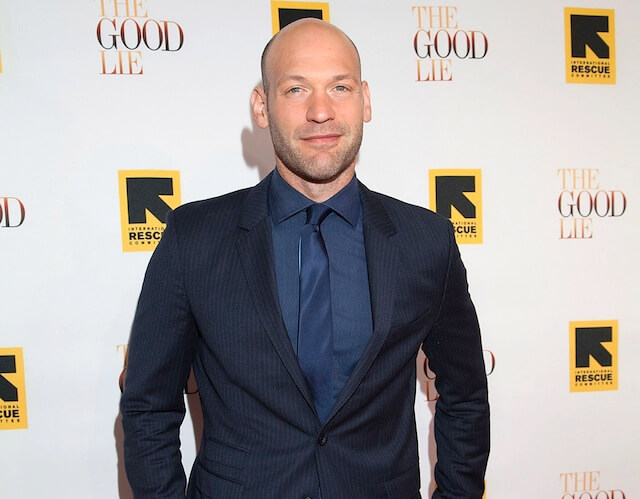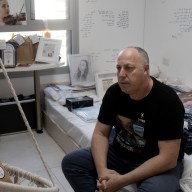Corey Stoll gets around. He was killed in the first season of “House of Cards,” but then he wound up getting the lead role on the Guillermo del Toro show “The Strain.” He’ll be seen next month in “Ant-Man,” and later this year in the Whitey Bulger drama “Black Mass,” plus the Gilliam Flynn movie “Dark Places.” Sometimes he has hair, as in “The Strain” or as Ernest Hemingway in “Midnight in Paris,” and sometimes he goes with his real-life bald head. Right now he’s in “Glass Chin,” a tiny, minimalist neo-noir in which he plays a fallen boxer who gets in deep with the mob. It’s an unusual indie in that most of it is talky scenes, usually done in one take, between he and seasoned vets like Billy Crudup, Kelly Lynch, Yul Vazquez and Katherine Waterston. It’s almost like theater — another thing Stoll frequently does. Many of the scenes in this movie are done in one take.
That is the hardest thing to do as an actor. That’s why the actors in “Birdman” were so highly praised, and rightfully so. You have to have this theatrical energy. You have to be on and have a sense of timing, and a sense of blocking. You have to know where to be in the frame. You can’t let go, like you can sometimes when you’re shooting in a more conventional way. But you’re also on film. It’s not theater. And the second you start looking like you’re acting, the illusion disappears and it’s a drag for the audience. Everyone, even those with smaller roles, needed to have that theatrical background to be able to be present but also consciously forming a performance. Were there takes where actors blew lines?
In general it was incredibly smooth. All the actors brought their A-game. There’s this incredible shot where Billy [Crudup] is dropping the hammer on me and letting me know the deal with the devil I’ve signed, and it’s this long tracking shot that follows him and comes back out. And we nailed it in one take and moved on. There were several times during the shoot where they’d say, “Moving on,” and we’d be like, “Excuse me? Are you sure you got it?” [Laughs] There is a certain power that comes with working with directors like Eastwood or Woody Allen, who work quickly and who don’t give you a million takes. It’s a call to arms. Actors realize this might be the only shot they get at a scene. You don’t want to get caught flat-footed or making a boring choice. The lack of cuts also mean that you don’t often get the traditional shot-reverse shot coverage.
A lot of times we had no coverage. A lot of times it was one angle. Noah [Buschel, director] didn’t have a chance to cut in there if the scene wasn’t working out. There were several scenes where there were two people talking and he only shot in one direction. He didn’t even get the footage of the other side of the conversation. Which takes some guts. [Laughs] Shots like those can be great for a viewer, but how is it for an actor?
It can be frustrating. [Laughs] Because you’re doing all this stuff, and you have this sense that it’s not being recorded. It’s not even being picked up. But then you have this director who has this incredibly clear point of view and this specific voice, which is exciting. That can take the pressure off in terms of the sense that you, as an actor, have to create everything. You are in this world and your job is to get as close to the truth as possible. And the director’s job is to direct the attention of the audience. This is a neo-noir. Did you wind up having to watch a lot of old noirs?
I watched a bunch of movies. I know that Noah was really interested in [Yasujiro] Ozu. There is this classical, minimalist thing going on in his film, which allow the action to happen in the very straight-on, symmetrical frame. I don’t want to make this a banal case of judging if your character is good or bad, but how did you view your character in terms of how unlikable he can be?
The character as written is very unlikable. He’s incredibly self-pitying and selfish and shallow. But there’s something that happens when you make a character like that the protagonist and then you screw him over. Suddenly there’s something likable about him. It’s this incredible alchemy. I tried to resist as much as possible doing anything that would make audiences like him. But what’s unlikable about him is not his immorality or his greed or his cruelty, even. He’s just a whiner. [Laughs] I think audiences can forgive murder and theft and betrayal a lot more than they can forgive self-pity. But it was fun to be that guy, that sadsack, who’s sort of the other end of the Brando character in “On the Waterfront.” There’s this pathos to that. But in this movie there’s something really petty about him. A lot of his journey is from pettiness to something resembling an honorable life. You jump around a lot, not only from theater to the screen, but from TV to films, from big movies to tiny indies. Even your look changes a lot. Do you get a lot of whiplash from it?
I put on a fair amount of weight for “Glass Chin.” It’s fun to change your look. But in terms of whiplash it’s very true. I just wrapped “The Strain,” I’m shooting a TV arc and then I’m shooting “The Seagull.” It couldn’t be more different. But that’s exciting, that’s energizing.
Corey Stoll on doing long takes for the neo-noir ‘Glass Chin’

Getty Images
Follow Matt Prigge on Twitter @mattprigge
















